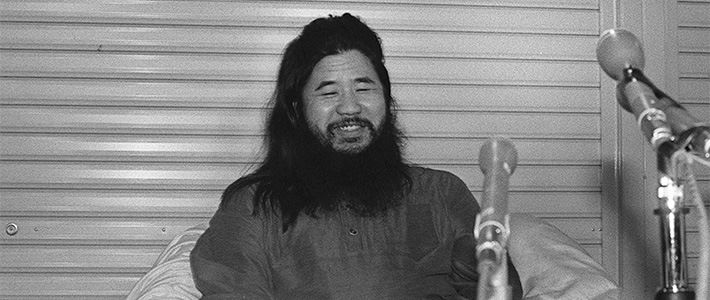
Aum Shinrikyō: A Timeline
Society
On the morning of July 6, Matsumoto Chizuo, who took the name Asahara Shōkō as leader of the Aum Shinrikyō cult, and six followers were executed for their role in orchestrating crimes and terrorist attacks that killed dozens. Below we give a chronology of incidents related to the deadly cult.
- English
- 日本語
- 简体字
- 繁體字
- Français
- Español
- العربية
- Русский
More than two decades have passed since the March 20, 1995, sarin gas attacks on the Tokyo subways, which killed 13 and injured thousands. Aum Shinrikyō, the cult led by guru Asahara Shōkō (born in 1955 as Matsumoto Chizuo), was responsible for this act, as well as another poison gas attack in Nagano Prefecture a year earlier and numerous other violent crimes. In all, 190 members of the cult were found guilty and sentenced for their roles in the cult’s illegal activities, with 13 receiving death sentences.
On July 6, 2018, the first of these death sentences were carried out, with Matsumoto and six other prisoners being executed after Minister of Justice Kamikawa Yōko signed the final orders. Below we look at major events in the history of Aum Shinrikyō and the aftermath of its attacks and dissolution.An Aum Shinrikyō Chronology
| February 1984 | Matsumoto Chizuo (Asahara Shōkō) launches Aum Shinsen no Kai. In June 1987 the group changes its name to Aum Shinrikyō. |
| November 1989 | Aum Shinrikyō members kill the lawyer Sakamoto Tsutsumi, his wife Satoko, and their 1-year-old son Tatsuhiko at their home in Yokohama. Sakamoto, a specialist in anticult activities, was engaged in a public relations campaign against Aum at the time of the murders. Their bodies are not found until September 1995, after Aum members arrested that year reveal the locations. |
| Autumn 1993 | Aum begins construction of a facility to produce the nerve agent Sarin at its compound in the village of Kamikuishiki, Yamanashi Prefecture. The facility is not completed, but the cult does succeed in making supplies of Sarin for use in attacks later. |
| June 1994 | Aum members release Sarin in a district of Matsumoto, Nagano Prefecture, where residents had opposed construction of a cult office. Eight are killed and hundreds more injured in the attack. |
| February 1995 | Aum members kidnap Kariya Kiyoshi, brother to a wealthy woman who had escaped the cult, to force him to reveal her whereabouts. They imprison him at the Kamikuishiki compound before killing him with an overdose of anesthetics and destroying his corpse. |
| March 20, 1995 | As the authorities’ net closes in on the cult, Matsumoto, fearing raids on Aum facilities, orders an attack on Tokyo’s subway system. Members release Sarin on cars of five trains traveling through Kasumigaseki Station, located under the main ministries of the central government. A total of 13 passengers and station personnel die in the attack, and some 6,000 are injured. |
| March 1995 | The Tokyo Metropolitan Police begin searches of all Aum Shinrikyō facilities. |
| May 16, 1995 | Matsumoto is discovered hiding in a secret chamber at the Kamikuishiki compound and placed under arrest. |
| October 1995 | The Tokyo District Court orders the dissolution of Aum Shinrikyō. |
| December 1999 | Former Aum spokesman Jōyū Fumihiro is released from prison. He rejoins Aum and takes a leading role in the remaining group. |
| February 2000 | The group officially renames itself Aleph. |
| February 2004 | The Tokyo District Court sentences Matsumoto to death; his legal team appeals the decision. |
| March 2006 | The Tokyo High Court dismisses Matsumoto’s appeal. |
| September 2006 | Japan’s Supreme Court rejects a special appeal from Matsumoto’s lawyers, ruling that he is sane and can be held responsible for his actions. With this his death sentence is finalized. |
| May 2007 | Jōyū leaves Aleph, forming a new group called Hikari no Wa (Ring of Light). |
| June 2012 | Police capture Kikuchi Naoko and Takahashi Katsuya, the final Aum criminal suspects to remain on the run. |
| 2014–15 | Another group splinters off from Aleph. Led by former Aum member Yamada Misako, it is active mainly in Ishikawa Prefecture. |
| January 2018 | The Supreme Court rejects Takahashi’s final appeal, sentencing him to life in prison to end the last Aum-related trial. |
| July 6, 2018 | Matsumoto and six of his followers on death row are executed in the early morning hours. Six Aum members remain on death row, and the authorities are on alert for signs of trouble from the remaining Aum-related groups. |
| July 9, 2018 | Asahara’s remains are burned at a crematorium in Fuchū, Tokyo. The Ministry of Justice is preparing to hand his ashes over to one of his daughters, despite concerns that they could be the focus of further cult activities. |